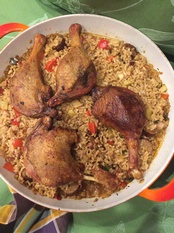WINE WITH…Jambalaya with Duck Legs
Vocabulary.com begins its definition of jambalaya as, “a Cajun dish with rice and a variety of ingredients. It has a little of everything and it’s very spicy.” They aren’t kidding when they mention “a little of everything.” Among ingredients that turn up in various jambalaya

recipes are turkey, chicken, ham, shrimp, oysters, and even alligator. Some jambalayas are made only with stock (chicken, beef or vegetable) while “red jambalaya” includes tomatoes. Obviously there is a lot of leeway here, although certain things are sacrosanct when it comes to jambalaya: Rice, spice (which can range from moderate to blazing), and a “trinity” of celery, onions and bell pepper. As opposed to gumbo, in which the rice is cooked and served separately topped with the other ingredients, in jambalaya the rice is simmered along with everything else.
Andouille sausage is pretty much a requisite ingredient in jambalaya, as is ham, preferably Cajun Tasso ham, but these are not always available in all markets. Both can be ordered online, but since we needed them right away we asked our butcher to suggest substitutes. He recommended spicy chorizo sausage to replace the Andouille, and uncured pancetta instead of the tasso, and we were very pleased with the results.
One last note about ingredients: Cindy Wolf, the chef at Charleston (one of Baltimore’s premiere restaurants) and a five-time James Beard award nominee, is a specialist in low country cuisine. She once said that she never uses green bell peppers in her jambalaya or other recipes any more, preferring instead the more complex and less harsh flavors of poblano pepper. We have been following this dictum ourselves ever since.
Jambalaya With Duck Legs
Serves 4
Both the duck legs and the jambalaya can be made up to a day ahead of time.
4 duck legs
salt and pepper
2 stalks celery, minced
1 cup minced onions
1 poblano pepper (or green bell pepper), minced
1 red bell pepper, minced
2-4 cloves garlic, minced
1 pound Andouille or smoked chorizo sausage, sliced
4 ounces diced uncured pancetta
2 cups long grain rice
1 tablespoon paprika
1 teaspoon dried thyme
1 teaspoon dried oregano
¼ teaspoon cayenne pepper or Tabasco sauce (or more for a spicier jambalaya)
3 cups chicken broth
For the Duck:
Preheat oven to 400°
Using scissors, trim off excess fat from the duck legs. Pat them dry and season both sides with salt and pepper. Place them, skin side down, in a heavy skillet (cast iron works well) and sear over high heat until nicely browned but not burned (about 5 minutes); then flip them over and sear the other side until browned, about 3 minutes. Spoon off and reserve all but about one tablespoon of the fat. Add enough of the chicken stock to come almost to the top the duck legs, but do not submerge them. Place the duck legs in the oven, skin side up, and roast for about 30 minutes, or until they are completely tender when poked with a sharp knife. Reserve the cooking liquid and the legs until ready to use (they may be refrigerated overnight and reheated, uncovered, in the oven before serving).
For the Jambalaya:
Heat the reserved tablespoon of duck fat in a large skillet and add the celery, onions, poblano, and red peppers. Cook, stirring frequently, until the mixture begins to soften; then stir in the garlic, the sausage, and the pancetta. When everything has begun to color, stir in the rice. Add the paprika, thyme, oregano, and cayenne. Pour in the chicken stock and simmer, covered, until the rice is just tender, about 20-30 minutes (if you are making it ahead of time and are planning to reheat the jambalaya, cook until the rice still has a little bite to it as it will soften further as it is reheated). May be made up to a day before serving.
To serve, stir the reserved duck-cooking liquid into the jambalaya and reheat it if necessary (the finished dish should be a little soupy). Reheat the duck legs, uncovered, in a pre-heated 400° oven for about 10 minutes. Place the duck legs on top of the jambalaya and serve at once.
* * *
This surely is more of a red than a white wine dish, but we did try a couple of whites with it, and one--a rich Chardonnay--worked extremely well. Otherwise, we’re recommending only reds, all of which are fairly full-bodied. This turns out to be a pairing in which a red wine’s tannins will scarcely be noticeable, so don’t fear trying something powerful or intense.